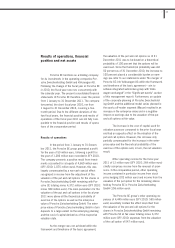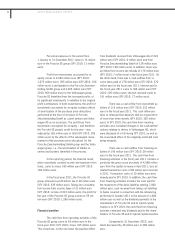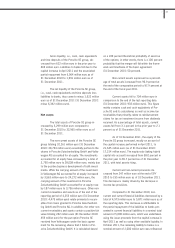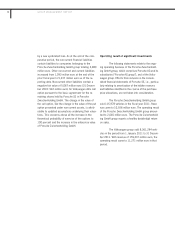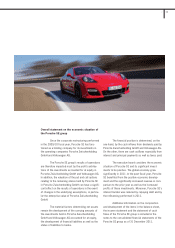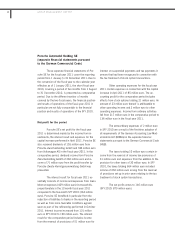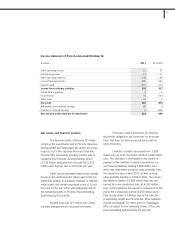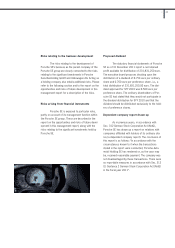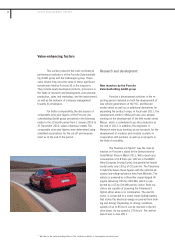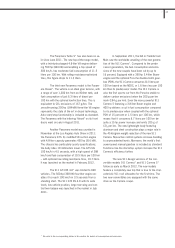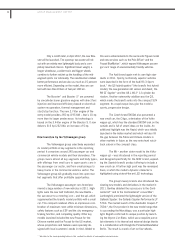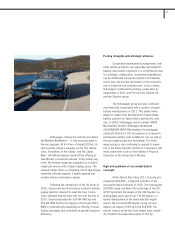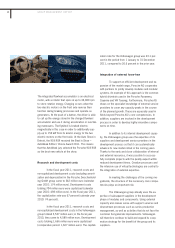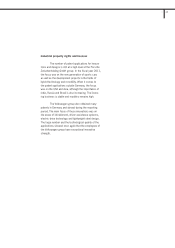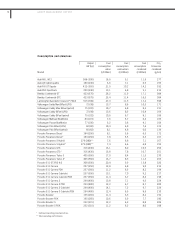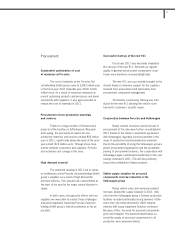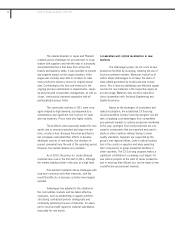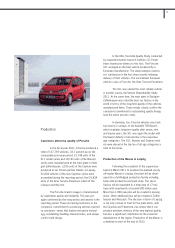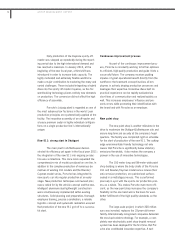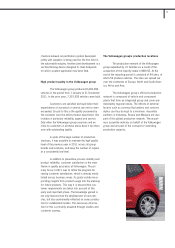Porsche 2011 Annual Report Download - page 65
Download and view the complete annual report
Please find page 65 of the 2011 Porsche annual report below. You can navigate through the pages in the report by either clicking on the pages listed below, or by using the keyword search tool below to find specific information within the annual report.
The Panamera Turbo S* has also been on sa-
le since June 2011. The new top-of-the-range model,
with a twin-turbocharged 4.8-liter V8 engine deliver-
ing 550 hp (404 kW) and enabling a top speed of
306 km/h, has moderate fuel consumption of 11.5
liters per 100 km. With rolling resistance-optimized
tires, this figure drops to 11.3 liters.
The third new Panamera model is the Panam-
era Diesel*. The vehicle is an ideal gran turismo, with
a range of over 1,200 km from an 80-liter tank, and
fuel consumption of just 6.3 liters of diesel per
100 km with the optional low-friction tires. This is
equivalent to CO2 emissions of 167 g/km. The
smooth-running 250-hp (184-kW) three-liter V6 engine
represents the state of the art in diesel technology.
Auto start/stop functionality is included as standard.
The Panamera with the lettering “diesel” on its front
doors went on sale in August 2011.
Another Panamera model was unveiled in
November at the Los Angeles Auto Show in 2011:
the Panamera GTS. Its modified V8 suction engine
with 4.8-liter capacity generates 430 hp (316 kW).
The chassis has particularly sporty specifications;
the body rides 10 millimeters lower. The GTS hits
100 km/h in 4.5 seconds, with a high speed of 288
km/h and fuel consumption of 10.9 liters per 100 km
– with optional low-rolling-resistance tires, 10.7 liters.
It was launched on the market in February 2012.
The 911 GT3 RS 4.0* was limited to 600
vehicles. The 500-hp (368 kW) four-liter engine en-
ables it to reach 100 km/h in 3.9 seconds from a
standing start. The 911 GT3 RS 4.0 with its wide
track, low vehicle position, large rear wing and cen-
tral twin tailpipe was launched in the market in July
2011.
In September 2011, the IAA in Frankfurt am
Main saw the worldwide unveiling of the new genera-
tion of the 911 Carrera*. Compared to the prede-
cessor generation, the fuel consumption and emis-
sions of the new coupés have been cut by up to
16 percent. Equipped with a 350-hp 3.4-liter Boxer
engine and the optional Porsche double-clutch gear-
box (PDK), the 911 Carrera consumes 8.2 liters per
100 km based on the NEDC, or 1.6 liters less per 100
km than its predecessor model. The 911 Carrera is
also the first sports car from the Porsche stable to
deliver carbon emissions below the 200 g per km
mark (194 g per km). Even the more powerful 911
Carrera S featuring a 3.8-liter Boxer engine and
400 hp delivers a cut in fuel consumption compared
to its predecessor when coupled with the optional
PDK of 15 percent or 1.5 liters per 100 km, which
means that it consumes 8.7 liters per 100 km de-
spite a 15 hp power increase and emits 205 g of
CO2 per km. The new lightweight body featuring
aluminum and steel construction plays a major role in
the 45 kilogram weight reduction of the new 911
Carrera. New active control systems increase handling
to unprecedented levels. Moreover, the world's first
seven-speed manual gearbox is included as standard.
Functions like the start-stop system increase the 911
Carrera’s efficiency further.
The new 911 design versions of the con-
vertible models 911 Carrera* and 911 Carrera S*
follow as early as March 2012. The new models
feature a completely new top that is true to the char-
acteristic 911 roof silhouette for the first time. The
two new convertibles are equipped with the same
drive as the Carrera coupé.
* We refer to the corresponding tables in this section for details of consumption and emissions.
65
2


